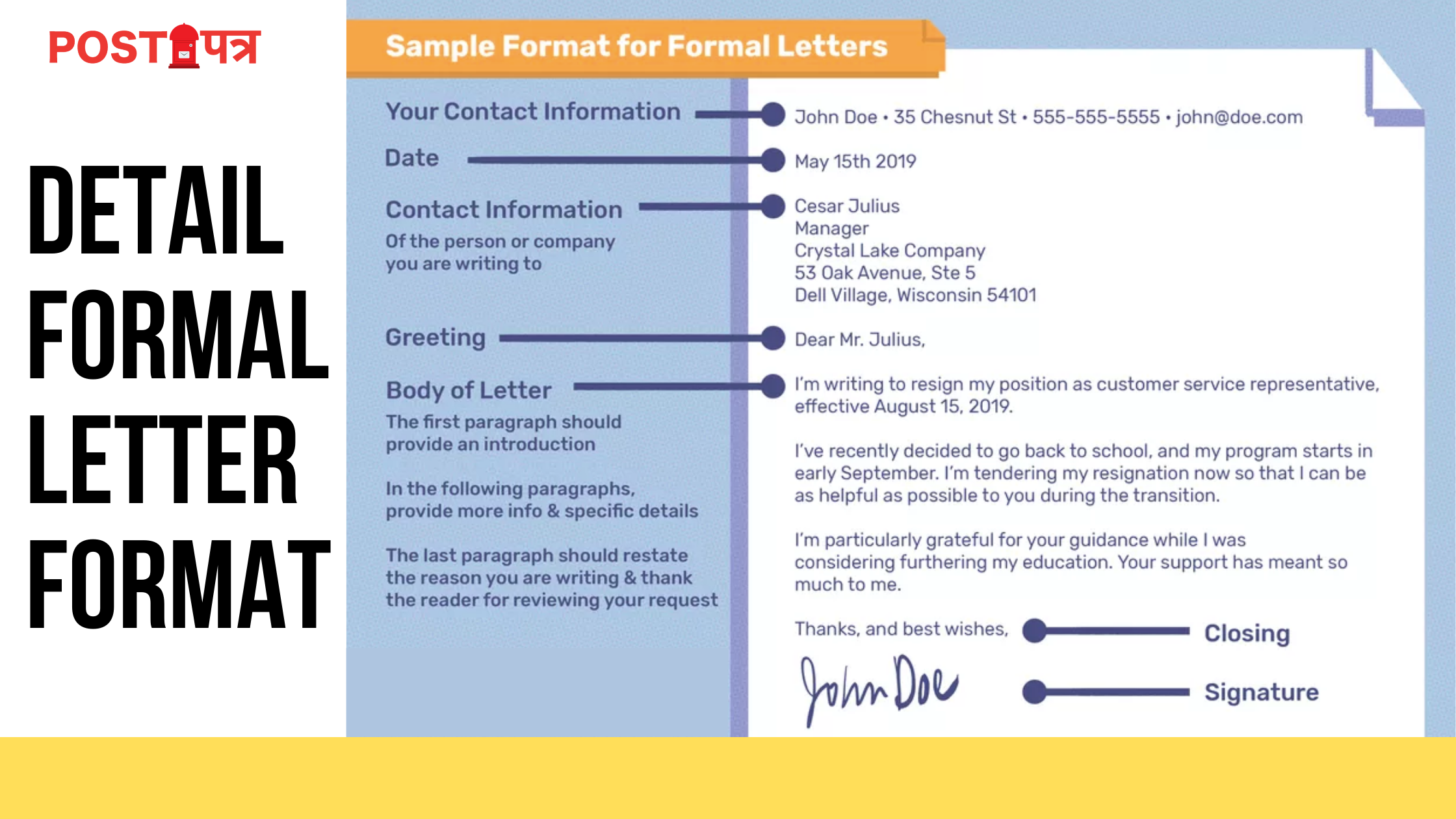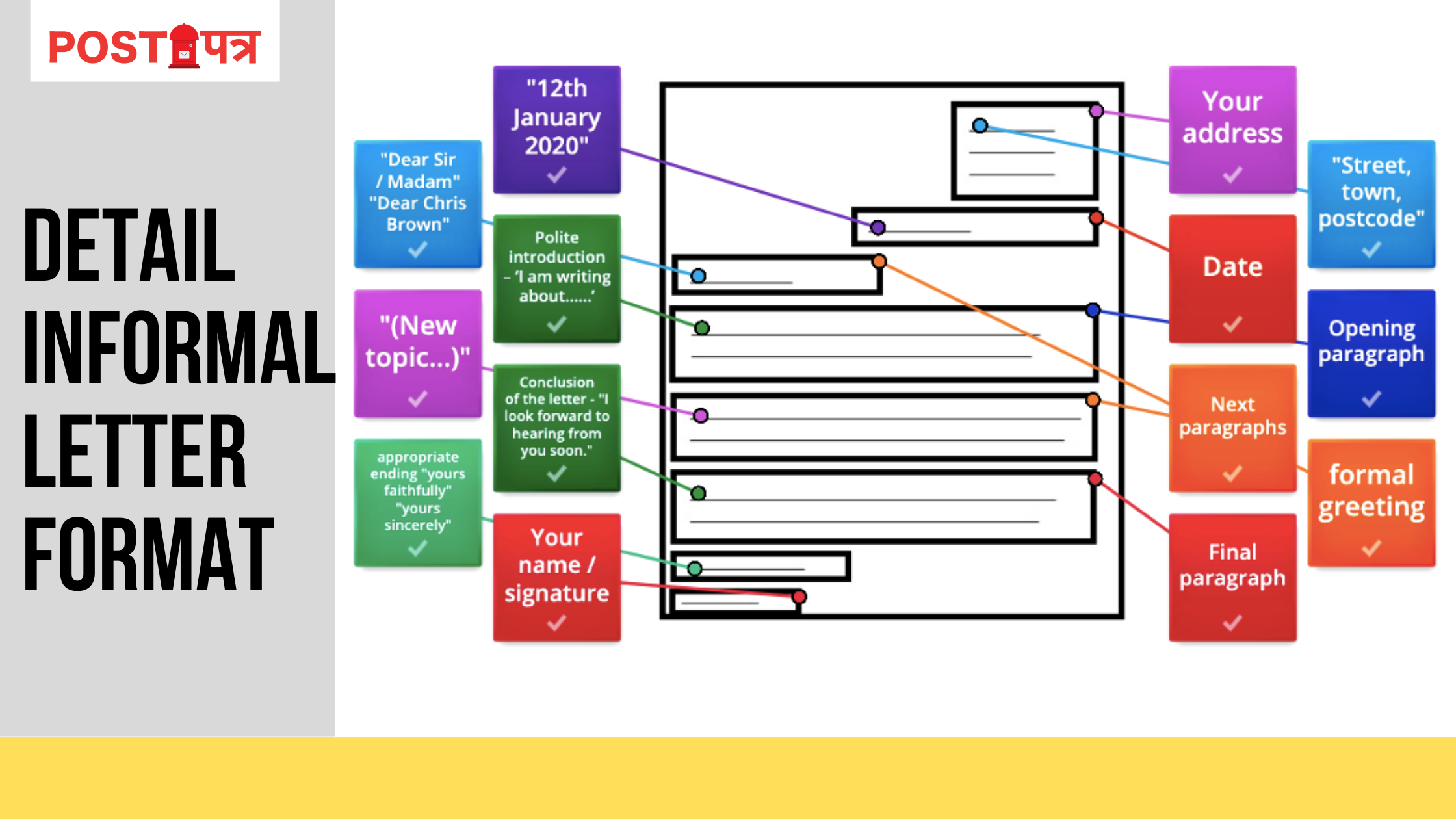Even in today’s fast-paced world of text messages and instant communication, there are still many reasons to send a standard letter every once during a while.
Thankfully, the whole process is incredibly simple and easy, meaning you’ll focus most of your attention on the contents of the letter itself.
Knowing the way to write a letter may be a fundamental skill you’ll use in business, school, and private relationships to speak information, goodwill, or simply affection.
There may be a basic guide to putting your thoughts on paper within the correct format.
Let’s first know the format of the letter:
Type 1: Formal Letter:

Way to write a formal letter:
- Write a proper letter when addressing someone you simply know during a professional capacity. This includes letters written to government departments or businesses, rather than a known individual.
- Write your address and today’s date at the highest of the page. Write your name and address at the highest of the page, on the left. If you’re writing a letter, use the corporate name and address instead, or simply write off the company letterhead. differently, skip two lines and write today’s date.
- Now write the name and address of the recipient. Unless you’re writing an email, skip another two lines, and write the contact information for the recipient. Use a separate line for each.
- Write the gesture. Let’s skip a line again, then greet the person with “Dear” followed by their name. you’ll use the surname, or the complete name (first and last), but never the primary name alone. Include an abbreviated professional title if applicable.
- Write your letter. Formal letters should open with a transparent statement of purpose. don’t use contractions (write aren’t rather than aren’t), and phrase questions formally (Would you have an interest in…? rather than does one want to…?). Proofread the letter for spelling and grammar when finished, or ask a lover to assist you.
- Use an admiring close. An admiring close ends your letter on an honest note and establishes a reference to the recipient. Make two hard returns after the last paragraph of the letter, then write the admiring close. For formal letters, stick with “Sincerely yours,” “Kindest regards,” or “Best wishes.” Sign underneath the close.
Type 2: Informal Letter:

Way to write an Informal letter:
- Decide how formal your letter must be. How you write the letter will depend upon your relationship with the recipient.
- Start with a salutation. The salutation you employ will depend upon your relationship with the recipient of the letter, also because of the formality of the letter.
- Now let’s start the letter. Move to the subsequent line and begin writing. If you’re writing a private letter, start by asking after the recipient’s well-being. this will be as formal as “I hope you’re well” or as informal as “How’s it going?.” Imagine the recipient is ahead of you; how would you ask them?
- Write what must be communicated. the first purpose of a letter is communication. Let the opposite person know what is going on on in your life, including the small print . for instance, don’t just tell your grandma “Thank you for the gift” — show her that it means something to you: “My friends and that I spent all night playing the sport you sent me. Thank you!” let the topic it won’t matter, exchange information shall be the main goal of the letter.
- End the letter. for casual letters, your close should reflect your relationship with the recipient. If you’re writing to a spouse, dear friend, or close loved one, you’ll use “Affectionately,” “Fondly” or “Love.” For a semi-formal letter, you would possibly find a far better match with “Sincerely,” “Regards,” or “Best.”
Now it’s time for posting a letter:
- Choose an envelope. it is vital to seek out the proper envelope for your letter. If you select an envelope of Very light construction, for instance, any heavy contents might break through the envelope while it’s in transit.
- Enclose the letter and seal the envelope. Once you’ve chosen the envelope for your letter, place the letter inside and lick the sting of the envelope to moisten the glue, then press it to shut to seal the letter.
- Address the envelope. Write the address of the recipient within the middle of the front of the envelope. Include the recipient’s name, apartment or house number, street name, city, state or province, and zip or zip code. Use the nine- or eleven-digit postcode if you recognize it. you’ll use the two-letter zip code for the state if you would like. Use clear, printed, upper-case letters written in dark ink in order that any postal employee is going to be ready to read your writing quickly and accurately
- Write your address. within the top-left corner of the envelope, write your name and address. For simple postal handling, it’s better to write down your address on the front of the envelope instead of the rear. You’ll also use a printed return address label. Including your address will make sure that the letter comes back to you if for a few reasons it doesn’t make it to the recipient.
Sending letters has been a traditional way of communication for centuries, but with the advent of technology, it’s become less common. However, there’s still something special about receiving a physical letter in the mail. If you’re looking to send a letter hassle-free, consider using Postpatra.com. With Postpatra, you can write your letter online and customize it as per your needs. Simply provide the sender and receiver’s name and address, and your letter will be printed, packed, and delivered by us. You can even track your letter online from the comfort of your home. Say goodbye to the hassle of sending letters and embrace the convenience of Postpatra.com!











